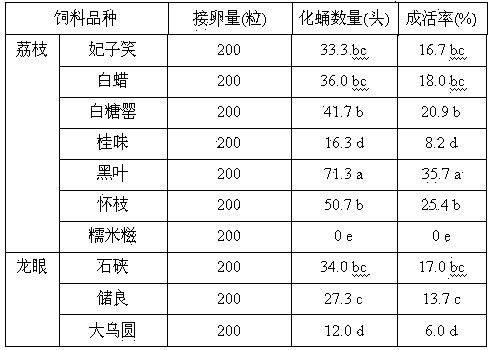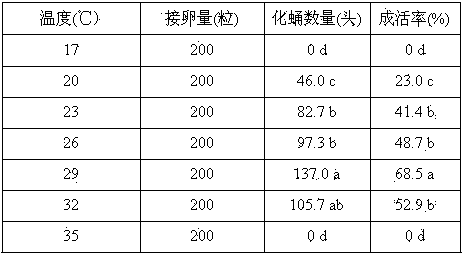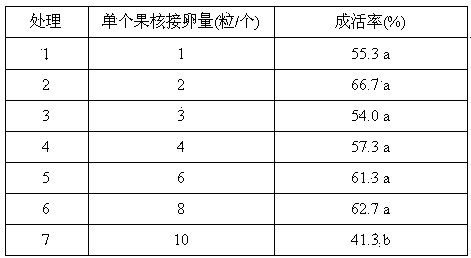Method for rearing litchi fruit borers
A technology for lychee stem borer and lychee, which is applied in the field of feeding lychee stem borer, can solve the problems of unsatisfactory feeding effect and large amount of feed, and achieve the effects of mass feeding, reducing the amount of feed and improving the use efficiency.
- Summary
- Abstract
- Description
- Claims
- Application Information
AI Technical Summary
Problems solved by technology
Method used
Image
Examples
Embodiment 1
[0023] Embodiment 1 The rearing of litchi pedicle borer larvae
[0024] S1. Determination of the type of feed for larva rearing
[0025] They are raised in an artificial climate chamber, and the feed is lychee or longan fruit stones. There are 7 varieties of lychee: Feizixiao, Baiwa, Baitangying, Guiwei, Heiye, Huaizhi, and Nuomici; There are 3 varieties of Wuyuan and Chuliang. Peel the fruit of the above 10 varieties, remove the flesh, take the core, wash it with water, soak it in 75% alcohol for 3-5 minutes, dry it, and set it aside. Cut a thin slit on the top of the fruit core, insert an egg into the incision, then put the fruit core into a petri dish lined with wet filter paper, spread out in a single layer, and then put the petri dish into a white porcelain plate. Each variety received 200 eggs and repeated 3 times. The feeding temperature is 25°C, and the photoperiod is L:D=12h:12h. After the larvae are mature, they crawl out of the fruit core, spin silk and cocoon a...
Embodiment 2
[0051] Embodiment 2 The rearing of adult moths of litchi pedicle borers
[0052] S1. Determination of photoperiod for adult moth rearing
[0053] The moths were reared in insect cages at a room temperature of 26°C and a humidity of 80%RH, and the size of the insect cages was 30cm×30cm×30cm. Two 40-watt fluorescent lamps are installed at 50 cm directly above the insect cage to control the photoperiod by turning on or turning off the lights. Put 50 female moths and 50 male moths in the cage, totaling 100 moths. Cotton blocks with 10% honey water are placed in the insect cage to supplement nutrition, and 6 litchi or longan fruits wrapped in white toilet paper are placed as oviposition media to induce adult moths to lay eggs on the toilet paper . Set 3 photoperiod treatments: L:D=24h:0, 12h:12h and 0:24h, repeat 3 times. After adult moths laid eggs, the toilet paper was changed every day, and the number of eggs on the toilet paper was recorded. The investigation was conducted ...
Embodiment 3
[0068] Embodiment 3 Determination of egg and pupa cryopreservation temperature
[0069] Store the eggs in an artificial climate box with a humidity of 95%RH, set three temperatures of 10°C, 12°C and 14°C to store eggs, and record the egg hatching situation regularly. Set three temperatures of 14°C, 16°C and 18°C to preserve the pupae, and regularly record the emergence of adult moths. The results are shown in Table 9. The results in Table 9 show that at 10-14°C, it takes 10-20 days for the pedicle borer eggs to hatch; at 14-18°C, it takes 12-22 days for adult moths to hatch.
[0070] Table 9 Egg hatching and pupal moth emergence of pedicle borers at different temperatures
[0071]
[0072] Note: "–" means no egg hatching or no adult moth emerging; "√" means egg hatching or adult moth emerging.
PUM
 Login to View More
Login to View More Abstract
Description
Claims
Application Information
 Login to View More
Login to View More - R&D
- Intellectual Property
- Life Sciences
- Materials
- Tech Scout
- Unparalleled Data Quality
- Higher Quality Content
- 60% Fewer Hallucinations
Browse by: Latest US Patents, China's latest patents, Technical Efficacy Thesaurus, Application Domain, Technology Topic, Popular Technical Reports.
© 2025 PatSnap. All rights reserved.Legal|Privacy policy|Modern Slavery Act Transparency Statement|Sitemap|About US| Contact US: help@patsnap.com



